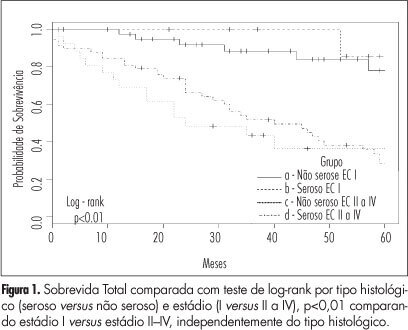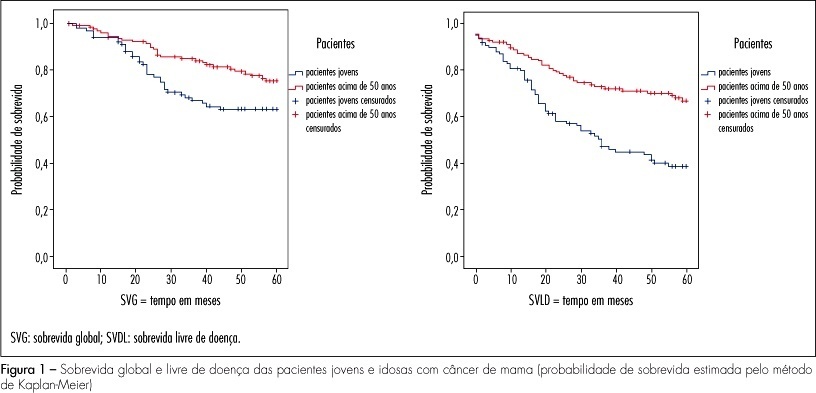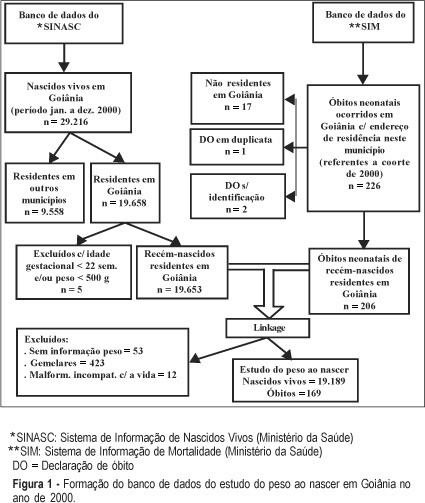Summary
Revista Brasileira de Ginecologia e Obstetrícia. 2012;34(5):196-202
DOI 10.1590/S0100-72032012000500002
PURPOSE: To compare the clinical-pathological features of women with serous and non-serous ovarian tumors and to identify the factors associated with survival. METHODS: In this reconstructed cohort study, 152 women with ovarian carcinoma, who attended medical consultations between 1993 and 2008 and who were followed-up until 2010 were included. The histological type was clearly established for all women: 81 serous carcinomas and 71 non-serous tumors (17 endometrioid, 44 mucinous and 10 clear cell carcinomas). The crude and adjusted odds ratios (OR), with the respective 95% confidence intervals (95%CI), were calculated for the clinical and pathological features, comparing serous and non-serous histological types. The Hazard Ratios (HR) with 95%CI was calculated for overall survival, considering the clinical and pathological features. RESULTS: Comparison of serous to non-serous tumor types by univariate analysis revealed that serous tumors were more frequently found in postmenopausal women, and were predominantly high histological grade (G2 and G3), advanced stage, with CA125>250 U/mL, and with positive peritoneal cytology. After multivariate regression, the only association remaining was that of high histological grade with serous tumors (adjusted OR 15.1; 95%CI 2.9-77.9). We observed 58 deaths from the disease. There was no difference in overall survival between women with serous carcinoma and women with non-serous carcinoma (HR 0.4; 95%CI 0.1 - 1.1). It was observed that women aged 50 years or less (HR 0.4; 95%CI 0.1-0.9) and those who were in menacne (HR 0.3; 95%CI 0.1-0.9) had a longer survival compared respectively to those above 50 years of age and menopaused. High histological grade (G2 and G3) (p<0.01), stages II-IV (p<0.008) and positive cytology (p<0.001) were significantly associated with worse prognosis. CA125 and the presence of ascites did not correlate with survival. Survival was poor when the disease was diagnosed in stages II to IV and compared to stage I (log-rank p<0.01) regardless of histological type (serous and non-serous). CONCLUSIONS: The proportion of high histological grade (G2 and G3) was significantly higher among serous than non-serous carcinomas. Serous and non-serous histological types were not related to overall survival.

Summary
Revista Brasileira de Ginecologia e Obstetrícia. 2009;31(2):54-60
DOI 10.1590/S0100-72032009000200002
PURPOSE: the objective of this study was to evaluate the clinical, pathological and molecular characteristics in very young women and postmenopausal women with breast cancer. METHODS: we selected 106 cases of breast cancer of very young women (<35 years) and 130 cases of postmenopausal women. We evaluated clinical characteristics of patients (age at diagnosis, ethnic group, family history of breast cancer, staging, presence of distant metastases, overall and disease-free survival), pathological characteristics of tumors (tumor size, histological type and grade, axillary lymph nodes status) and expression of molecular markers (hormone receptors, HER2, p53, p63, cytokeratins 5 and 14, and EGFR), using immunohistochemistry and tissue microarray. RESULTS: when comparing clinicopathologic variables between the age groups, younger women demonstrated greater frequency of nulliparity (p=0.03), larger tumors (p<0.000), higher stage disease (p=0.01), lymph node positivity (p=0.001), and higher grade tumors (p=0.004). Most of the young patients received chemotherapy (90.8%) and radiotherapy (85.2%) and less tamoxifen therapy (31.5%) comparing with postmenopausal women. Lower estrogen receptor positivity 49.1% (p=0.01) and higher HER2 overexpression 28.7% (p=0.03) were observed in young women. In 32 young patients (29.6%) and in 20% of the posmenopausal women, the breast carcinomas were of the triple-negative phenotype (p=0.034). In 16 young women (50%) and in 10 postmenopausal women (7.7%), the tumors expressed positivity for cytokeratin 5 and/or 14, basal phenotype (p=0.064). Systemic metastases were detected in 55.3% of the young women and in 39.2% of the postmenopausal women. Breast cancer overall survival and disease-free survival in five years were, respectively, 63 and 39% for young women and 75 and 67% for postmenopausal women. CONCLUSIONS: breast cancer arising in very young women showed negative clinicobiological characteristics and more aggressive tumors.

Summary
Revista Brasileira de Ginecologia e Obstetrícia. 2009;31(1):22-27
DOI 10.1590/S0100-72032009000100005
PURPOSE: to analyze complications, morbidity, mortality and survival rate in a group of patients with cervical cancer with central pelvic relapse after primary radiotherapy treatment. METHODS: retrospective study of a series of 16 cases of pelvic exenteration after primary radiotherapy treatment. Descriptive statistics, survival curve through Kaplan-Meier's method, and regression analysis to evaluate prognosis were performed. RESULTS: sixteen patients have undergone pelvic exenteration. Epidermoid carcinoma, IIb stage and undifferentiated grade were the most frequent conditions. Post-operatory tumor relapse occurred in half the cases. Eleven patients presented peri or post-surgical complications, the most frequent being pelvic infection, that of the surgical wound, and urinary fistulae. Global survival rate was 64.3%, with average follow-up of 11 months. Regression analysis did not detect any significant prognosis factor for the patient survival. CONCLUSIONS: the survival rate was 64.3%. No particular factor associated to poor prognosis has been found in the present series of cases.
Summary
Revista Brasileira de Ginecologia e Obstetrícia. 2005;27(3):130-136
DOI 10.1590/S0100-72032005000300006
PURPOSE: to analyze birth weight in a cohort of newborns for the year 2000, in Goiânia, by determining the coefficient of mortality and neonatal survival probability, stratified by categories of birth weight, and also, through the identification of factors associated with low birth weight (LBW). METHODS: a retrospective cohort study, made possible by the linkage of data from the ISM (Information System on Mortality) and ISLB (Information System on Live Births) files. Coefficients of neonatal mortality were calculated for the categories of birth weight and a neonatal survival probability chart was constructed with the help of linear regression analysis. Risk factors for LBW were identified by univariate analysis (RR) and logistic regression analysis, and the level of significance was set at 5%. RESULTS: the incidence of LBW was 6.9% and 140 (66.8%) neonatal deaths took place in this group. Thirty percent of these deaths occurred in the 1,500-2,500 g weight bracket. The following risk factors were identified for LBW: preterm pregnancy, presence of congenital malformations, mothers at the extreme ages for reproduction, mothers living in the northwestern region of the city, insufficient prenatal appointments with the doctor, delivery in a public hospital, and female babies. CONCLUSION: Goiânia had an incidence of LBW which is comparable to that of developed countries and coefficients of neonatal mortality by category of weight were below those found for those countries. These results recommend that we pay attention to: prematurity, public hospitals, and the northwestern region of Goiânia.
